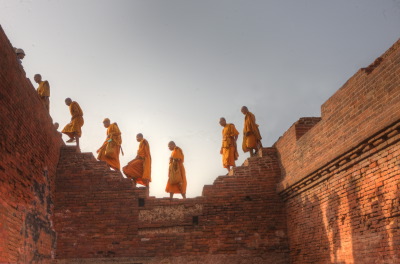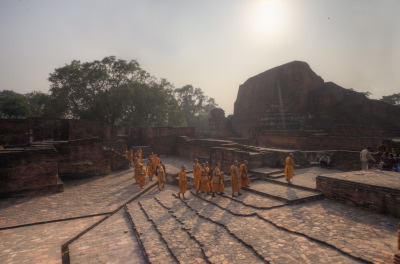After Kusinagar and Kesaria, our pilgrimage took us the great University of Nalanda, about 90 kms south east of Patna and a few kms away from Rajgir.
Nalanda was one of the world’s first universities and the largest Buddhist University in history. It was established during the reign of the Gupta emperor Kumaragupta. The complex was built with red bricks and its ruins occupy an area of 14 hectares.
The Buddha is said to have stayed several times at Nalanda. Later, King Asoka (250 BC) built a stupa in the memory of Shariputra, on the two close disciples of the Buddha. The ruin of this stupa is the largest surviving monument at Nalanda (see photo below).
Many of the great Indian panditas taught at Nalanda, including Nagajurna, Aryadeva, Chandrakirti and Shantideva.
In its heyday it accommodated over 10,000 students and 2,000 teachers. The university was considered an architectural masterpiece, and was marked by a lofty wall and one gate. Nalanda had eight separate compounds and ten temples, along with many other meditation halls and classrooms. On the grounds were lakes and parks.
The subjects taught at Nalanda University covered every field of learning, and it attracted pupils and scholars from Korea, Japan, China, Tibet, Indonesia, Persia and Turkey. Students studied science, astronomy, medicine and chiefly metaphysics and philosophy.
The library of Nalanda, known as Dharma Gunj (Mountain of Truth) or Dharmagañja (Treasury of Truth), was the most renowned repository of Buddhist knowledge in the world. Its collection was said to comprise hundreds of thousands of volumes, so extensive that it burned for months when set aflame by Muslim invaders led by the Turk Bakhtiar Khilji in 1193. Thousand of monks were burned alive or killed.
His Holiness the Dalai Lama often says that the Tibetan Buddhist tradition belongs to the Nalanda tradition. It can thus be considered that the present day Tibetan Buddhist scholar still carry on the living tradition of Nalanda University.

 Thai monks passing in fronto of Shariputra Stupa
Thai monks passing in fronto of Shariputra Stupa